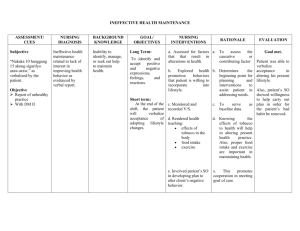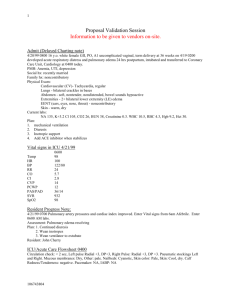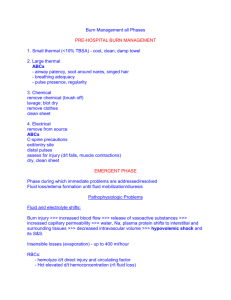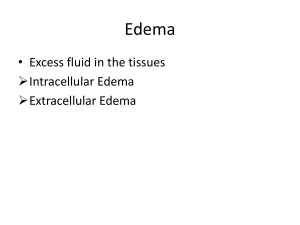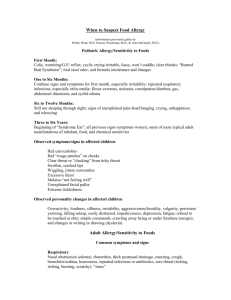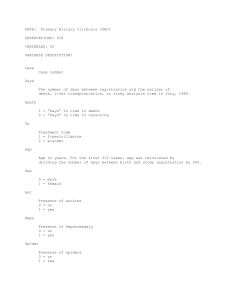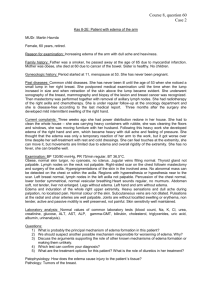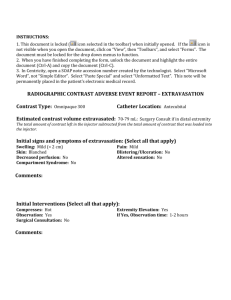Treatment of Post-Surgical Edema in the Orthopedic Patient — A
advertisement
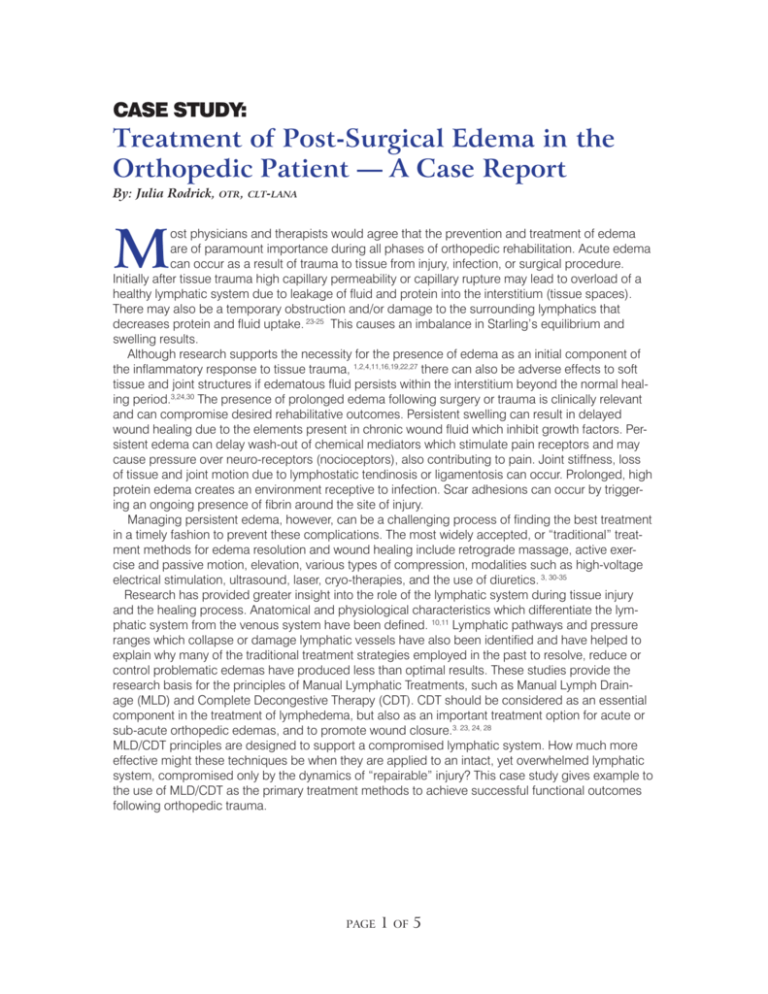
CASE STUDY: Treatment of Post-Surgical Edema in the Orthopedic Patient — A Case Report By: Julia Rodrick, otr, clt-lana M ost physicians and therapists would agree that the prevention and treatment of edema are of paramount importance during all phases of orthopedic rehabilitation. Acute edema can occur as a result of trauma to tissue from injury, infection, or surgical procedure. Initially after tissue trauma high capillary permeability or capillary rupture may lead to overload of a healthy lymphatic system due to leakage of fluid and protein into the interstitium (tissue spaces). There may also be a temporary obstruction and/or damage to the surrounding lymphatics that decreases protein and fluid uptake. 23-25 This causes an imbalance in Starling’s equilibrium and swelling results. Although research supports the necessity for the presence of edema as an initial component of the inflammatory response to tissue trauma, 1,2,4,11,16,19,22,27 there can also be adverse effects to soft tissue and joint structures if edematous fluid persists within the interstitium beyond the normal healing period.3,24,30 The presence of prolonged edema following surgery or trauma is clinically relevant and can compromise desired rehabilitative outcomes. Persistent swelling can result in delayed wound healing due to the elements present in chronic wound fluid which inhibit growth factors. Persistent edema can delay wash-out of chemical mediators which stimulate pain receptors and may cause pressure over neuro-receptors (nocioceptors), also contributing to pain. Joint stiffness, loss of tissue and joint motion due to lymphostatic tendinosis or ligamentosis can occur. Prolonged, high protein edema creates an environment receptive to infection. Scar adhesions can occur by triggering an ongoing presence of fibrin around the site of injury. Managing persistent edema, however, can be a challenging process of finding the best treatment in a timely fashion to prevent these complications. The most widely accepted, or “traditional” treatment methods for edema resolution and wound healing include retrograde massage, active exercise and passive motion, elevation, various types of compression, modalities such as high-voltage electrical stimulation, ultrasound, laser, cryo-therapies, and the use of diuretics. 3, 30-35 Research has provided greater insight into the role of the lymphatic system during tissue injury and the healing process. Anatomical and physiological characteristics which differentiate the lymphatic system from the venous system have been defined. 10,11 Lymphatic pathways and pressure ranges which collapse or damage lymphatic vessels have also been identified and have helped to explain why many of the traditional treatment strategies employed in the past to resolve, reduce or control problematic edemas have produced less than optimal results. These studies provide the research basis for the principles of Manual Lymphatic Treatments, such as Manual Lymph Drainage (MLD) and Complete Decongestive Therapy (CDT). CDT should be considered as an essential component in the treatment of lymphedema, but also as an important treatment option for acute or sub-acute orthopedic edemas, and to promote wound closure.3. 23, 24, 28 MLD/CDT principles are designed to support a compromised lymphatic system. How much more effective might these techniques be when they are applied to an intact, yet overwhelmed lymphatic system, compromised only by the dynamics of “repairable” injury? This case study gives example to the use of MLD/CDT as the primary treatment methods to achieve successful functional outcomes following orthopedic trauma. page 1 of 5 Medical History: This 45 year old male police officer with medical history of type 2 diabetes sustained a nonspecific traumatic crush injury which caused posterior interosseous nerve (PIN) palsy of the right forearm and dominant right hand. He experienced significant pain affecting the right forearm, with the point of compression thought to be the origin of the supinator muscle. The patient underwent exploration of the right forearm and release of the posterior interosseous nerve by an orthopedic surgeon. Surgery confirmed PIN compression proximal to the origin of the supinator muscle and complete decompression with release of the supinator was achieved. The fascia between the extensor carpi radialis brevis and the extensor digitorum communis was closed loosely to prevent tissue herniation. (Fascia is defined as the fibrous membrane covering, supporting and separating muscle. It also unites the skin with underlying tissue 37.) The wound was irrigated and hemostasis was achieved. The subcutaneous and skin tissues were sutured (3-0 Vicryl and PDS sutures). Following the procedure, dry dressings and a post-mold forearm to elbow splint was applied, positioning the elbow at 90 degrees and the forearm in neutral pronosupination. Within 24 hours after the procedure, the patient presented with severe swelling and was admitted to the hospital for surgical evacuation and decompression of a large hematoma in his right forearm. After the clot was debrided, the wound was left open for delayed primary closure to reduce the risk of undue tension on the wound from the tissue irritation and edema. Edema remained unresolved and severe pain/numbness/tingling persisted in the RUE. A referral was made to Occupational Therapy skilled services at 4 days post-op for wound care, interventions for pain control, and reduction of acute right forearm and hand edema. Specific directives were to reduce the swelling enough to allow for surgical closure at 8 to 9 days after the decompressive surgery. This directive limited therapy to a five day window for intervention. Clinical Presentation/Evaluation Findings: At the time of the Occupational Therapy evaluation, the patient presented with non-pitting, dense, indurated, edemeous tissue extending from the dorsal and palmar aspect of the right hand, progressing circumferentially throughout the right wrist extending 8 inches proximal to the wrist into the dorsal forearm. The tissue was tender to palpation with a significant lack of skin excursion surrounding the wound bed. Edema girth measurements were taken (see chart) showing significant differences between right and left extremities. The wound was full thickness and measured 18 cm x 10.3 cm, with exposed muscle evident. The edges of the wound bed were clean, without signs of infection. There was mild skin maceration at the peripheral borders and mild to moderate serosanguinous drainage (light red to pink, containing serum and blood 37) was present. The general color and temperature of the tissue appeared to be within normal limits. The patient’s active motion was within normal limits at the right shoulder and elbow but was severely impaired in the right forearm, wrist and hand due to neurological deficits and pain. Digits of the right hand were also painful and stiff. He demonstrated trace wrist and metacarpal flexor activity but no extensor activity at that time. The patient described his pain as “tingling, burning, throbbing and constant.” Plan of Care: Wound care directive from the physician included saline cleansing, followed by the application of a hydrogel and a sterile adaptic bandage to the wound bed to provide balanced hydration of the tissue daily (38). Absorbent dressings protected the surrounding tissue from maceration. Secondary dressings were applied to secure. The primary treatment objective beyond preventing infection was to reduce the high-protein fluid within the interstitium and reduce the swelling as quickly as possible in order to meet the deadline page 2 of 5 for surgical closure. As stated earlier, the presence of swelling following tissue trauma is an expected characteristic in the first stages of healing. “Inflammatory” or acute edema is expected to spontaneously reduce within 48 hours to 2 weeks following tissue injury. The traditional treatment of the R.I.C.E. formula (rest, ice, compression and elevation) is a vital first response in the event of an acute trauma. Rest allows for the tissue to heal and avoids repeated trauma. Ice will decrease blood flow (filtration) by causing sympathetic nerves to vasoconstrict, limiting the dynamics which may contribute to the formation of edema. Compression applied therapeutically to support both the venous and lymphatic systems may help by providing counterforce and cause slight changes in interstitial pressure to increase lymphatic pumping (fluid drainage). Elevation serves to assist in venous return and avoid the accumulation of lymphostatic fluid caused by dependent positioning. Gentle exercise within safe ranges is also helpful to stimulate the muscle pump and increase fluid flow as well. Specific considerations were made, however, in this patient’s case. The presentation of digital stiffness and density with tissue palpation suggested significant static fluid accumulation and the early production of collagenous tissue (24) due, in part, by neuro-dysfunction. This state could have contributed to poor perfusion of the tissue and impeded healing, in addition to causing joint stiffness. Also, the cycle of inflammation hindered pain resolution. The traditional methods of R.I.C.E. applied to the extremity produced little to no relief, therefore, the principles of manual Lymph drainage and complete decongestive therapies were employed. The patient received daily wound care followed by the decongestion of regional lymph nodes and proximal areas of the body, following traditional lymphatic drainage patterns (the venous angle, right lateral trunk and superficial/deep abdominal). Inter-axillary and axillio-inguinal anastomoses were also created to increase fluid flow to reduce the edema. Because of the presence of the forearm wound, no MLD was performed over the dorsal forearm. Over the secondary wound dressing, a light, two layered compression bandage was applied to protect the tissue from refill and facilitate the reduction of tissue density. The right arm was then moved passively through an arc of motion that was tolerable to the patient. He was encouraged to keep the bandages intact between treatments and was instructed in self-directed passive range of motion exercises to his tolerance. Clinical Outcome: Following the referral to Occupational Therapy, prompt intervention using a modified application of MLD and complete decongestive therapies resulted in a very favorable outcome for this patient. It allowed for a timely surgical closure (10-11-06). This was key in reducing the risk of infection, and promoting the continuation of healing. The patient progressed with referral to the Hand Center’s out patient orthopedic program for the continuation of therapy to facilitate rehabilitation specific to the patient’s deficits in fine motor skills secondary to the radial Edema Girth Measures nerve injury. Referral to OccuEval/tx Affected Unaffected S/p 5th Tx. Affected pational therapy 10-3-06 with 10/4/06 surgical closure 10-11-06. Girth reductions R. thumb 9.6 cm L. thumb 8.1 cm R. thumb 8.4 cm 1.2 cm R. index 8.1 cm L. index 7.4 cm R. index 7.7 cm 0.4 cm R.Transverse 26.8 Metacarpal bed R.Transverse Metacarpal bed 24.3 cm R.Transverse Metacarpal bed 24.5 cm 2.3 cm References R. Wrist L. Wrist 19.6 cm R. Wrist 20.3 cm 1.4 cm 1. Hunter, JM. Salvage of the Burned Hand. Surge Clin North Am. 1967; 47(5):1060. R. 4” prox. 25.9 cm L. 4” prox 21.9 cm R. 4”prox. 22.3 cm 4.6 cm R. 8” prox. 33.4 cm L. 8” prox. 28.4 cm R. 8” prox. 29. 7 cm 3.7 cm Julia Rodrick OTR/L, CLT-LANA Vital Care Therapy Services Morris, Illinois Email: handyotr86@aol.com 21.7 cm 2. Kloth LC, McCulloch JM. The Inflammatory Response to Wounding. In McCulloch JM, Kloth LC, Feeder JA (eds.) Wound Healing: Alternatives In Management. Philadelphia, Pa: FA Davis, 1995:3-15. page 3 of 5 3. Colditz JC. Therapist’s Management of the Stiff Hand. In: Hunter J, Macklin E Callahan A. (eds.), Rehabilitation of the hand: Surgery and therapy (4thed.) St. Louis, Mo: Mosby, 1995:1141-1145. 4. Flowers K. Edema: Differential Management Based on the Stages of Wound Healing. In: Hunter J, E. Macklin E, & A. Callahan A (eds.), Rehabilitation of the hand: as Surgery and therapy (4th ed.). St. Louis, Mo: Mosby, 1995: 87-91. 5. Hunter J, Mackin E. Edema techniques of evaluation and management. In: Hunter J, Macklin E, Callahan A (eds.). Rehabilitation of the hand: Surgery and therapy (4th Ed.). St. Louis, Mo: Mosby, 1995:77-85. 6. Villeco JP, Mackin E, Hunter JM. Edema: Therapist’s Management. In: Macklin E, Callahan A, Skirven T, Schneider L Osterman L (eds.), Rehabilitation of the Hand and Upper Extremity (5th ed). St. Louis, Mo: Mosby, 2002: 183-193. 7. Vasudevan S, Melvin J. Upper Extremity Edema Control; Rationale of the Techniques. American Journal of Occupational Therapy. 1979; 33: 8: 520-523. 8. Taber’s Cyclopedic Medical Dictionary, 15th edition; Philadelphia, Pa: F A Davis Co, 1985; Clayton L. Thomas, M.D., M.P.H 9. Vander A, Sherman J, Luciano D. Human Physiology: The Mechanisms of Body Function 6th edition. Mcgraw-Hill, Inc, 1994. 10. Guyton A C. Chapter 16. The Microcirculation and the Lymphatic System: Capillary Fluid Exchange, Interstitial fluid and Lymph Flow. In: Guyton AC, Hall JE (eds.). Philadelphia, Pa: WB Saunders, 1996, 11. Guyton A C. The lymphatic system, interstitial fluid dynamics, edema, and pulmonary fluid. In: Guyton A C (author) Textbook of Medical Physiology. Philadelphia, Pa: WB Saunders, 1986:361-373. 12. Casley-Smith J R, Casley-Smith J R Modern treatment of lymphoedema 5th Ed. Adelaide Australia: The Lymphe-dema Association of Australia, 1997. 13. Foldi M, Foldi E, Kubik S. Textbook of Lymphology for Physicians and Lymphedema Therapists. Munchen·Jena, Germany: Urban & Fischer, 2004,192. 14. Foldi E et al: The Lymphedema chaos: a lancet, Ann Plast Surg. 1989; 22:505. 15. Casely-Smith JR, Casely-Smith JR. Anatomy of the Lymphatic System for Physical Therapy. : Casely-Smith JR, Casely-Smith JR (authors) Modern Treatment for Lymphoedema, 5th edition. Malverne, South Australia: Lymphoedema Association of Australia, 1997: 25-40. 16. Howard SH, Krishnagiri S. The Use of Manual Edema Mobilization for the Reduction of Persistent Edema in the Upper Limb. J Hand Ther. 2001; 14: 291-301. 17. Bryant WM: Wound healing, Clin Symp. 1977; 29: 1. 18. Crowley L. Introduction to human disease ed.3.Boston, Mass: Jones and Barlett 19. Olszewski W. On the pathomechanism of development of postsurgical lymphedema. Lymphology.1973; 6: 35. 20. Deshaies LD. Comprehensive Management of Upper Extremity Edema. Physical Disabilities. Special Interest Section Quarterly. AOTA. 1977; 20: 3: 1-4. 21. Kennelty S. Techniques for Controlling Upper Extremity Edema. OT PRACTICE.1997; February: 24-26. 22. Byron PM, Muntzer EM. Therapist’s Management of the Mutilated Hand. Hand Clinics. 1986; Vol 2, No 1: 69-79. page 4 of 5 23. Sorrenson MK. The Edematous Hand. Phys Ther. 1989; 69: 1059-1064. 24. Artzberger S, Rodrick,J. Manual Edema Mobilization: a new concept in sub acute hand edema reduction. Israel Journal of Occupational Therapy. 2002;11 (2): E37-E63. 25. Casley-Smith JR, Gaffney RM. Excess plasma proteins as a cause of chronic inflammation and lymphedema. Quantitative Electron Microscopy. J. Pathology. 1981;133: 243-272. 26. Consensus Document of the International Society of Lymphology Executive Committee. The diagnosis and treatment of peripheral lymphedema. Lymphology. 1995; 28: 113-117. 27. Porth CM. Pathophysiology concepts of altered health states. 5th ed. Philadelphia, PA.:Lippincott, 1998 28. Howard S, Krishnagiri S. The use of manual edema mobilization for the reduction of .persistent edema in the upper limb. 2001;14 (4): 291-301. 29. Rosenberg L., de la Torre J. (2006). Wound Healing, Growth Factors. Emedicine.com. Accessed January 20, 2008. 30. Pedretti LW. Early MB (eds).Occupational Therapy. Practice Skills for Physical Dysfunction. St. Louis, Mo: Mosby, 2001 31. Bounko JM, Brannon WM, Dawes Jr KS, et al (2000) The efficacy of laser therapy in the treatment of wounds: a meta analysis of the literature. Proceedings 3rd Congress of the World Association for Laser Therapy: 79 32. Carati CJ, Anderson SN, Gannon BJ, Piller NB (2003) Treatment of post-mastectomy lymphoedema with low level laser therapy: a double blind, placebo controlled trial. Cancer 98(6): 1114–22 33. Burkhardt A. Joachim L: Clinical options in edema control, J hand Ther 6:337, 1997 34. Faghri P: The effects of neuromuscular stimulation-induced muscle contraction versus elevation on hand edema in CVA patients, J Hand Ther 10:2, 1997 35. Vasudevan S. Melvin J,. Upper extremity edema control: rationale of treatment techniques, Am J. Occup Ther 33:520, 1979 36. Physical Agent Modalities Practitioner Credentialing Course for the Occupational Therapy Practitioner; PAMPCA, Franklin, TN 37069-6515 37. Taber’s Cyclopedic Medical Dictionary, edition 15; (ed.) Thomas, Clayton L., M.D., M.P.H.; F.A. Davis Company, Philadelphia. 1985 38. Kloth LC, McCulloch JM. Chap. 3. In McCulloch JM, Kloth LC, Feeder JA (eds.) Wound Healing: Alternatives In Management. Philadelphia, Pa: FA Davis, 1995:3-15. page 5 of 5
